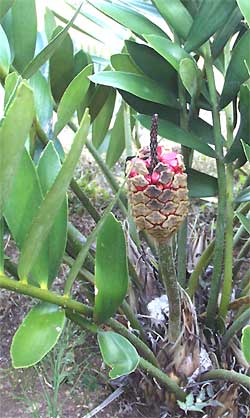Excerpts from Jim Conrad's
Naturalist Newsletter
from the February 11, 2006 Newsletter written at Hacienda San Juan Lizárraga one kilometer east of Telchac Pueblo, Yucatán, MÉXICO and issued from Hotel Reef Yucatan 13 kms to the north
A FRUITING CYCAD
 Among the interesting plants established at Hacienda San Juan by the previous owner are some cycads. One is fruiting now, and you can see it at the right.
Among the interesting plants established at Hacienda San Juan by the previous owner are some cycads. One is fruiting now, and you can see it at the right.
Except for its fruiting body, this particular cycad species looks like a large fern. Ferns reproduce with spores, however, and you can see that this fruiting body is a cone, almost like a pine cone. "Cone" is the right word, too, because cycads are gymnosperms, just like pines, spruce and firs.
One reason it's so wonderful to have cycads on the grounds is that MOST of the 289 or so cycad species on Earth are threatened, endangered, or no longer living in the wild -- known only from garden plantings. This is an unhappy state of affairs for a group of plants that reached its greatest period of abundance and diversity during the Age of Dinosaurs. Cycads are very primitive kinds of plants.
They come in male and female plants, the pollen being produced in male cones. Many cycad species are pollinated by insects, and it's interesting that usually the insects belong to primitive families. Typically the pollinators mate and lay eggs inside the female cone. It's believed that this reflects the fact that cycad pollination evolved before flowering plants appeared on Earth. Everything seems to point to the cycad's evolutionary antiquity, making them almost like living fossils.
I'm unsure which cycad species we have here but I'm guessing it's a member of the genus ZAMIA. In the old days there was just one Cycad Family, but now three are recognized: The Cycadaceae, Stangeriaceae, and the Zamiaceae.
You can read a lot more about cycad botany at http://www.conifers.org/cycadales.htm.
The Cycad Society provides a page with many thumbnail pictures you can click on to enlarge at http://www.cycad.org/photos.htm.